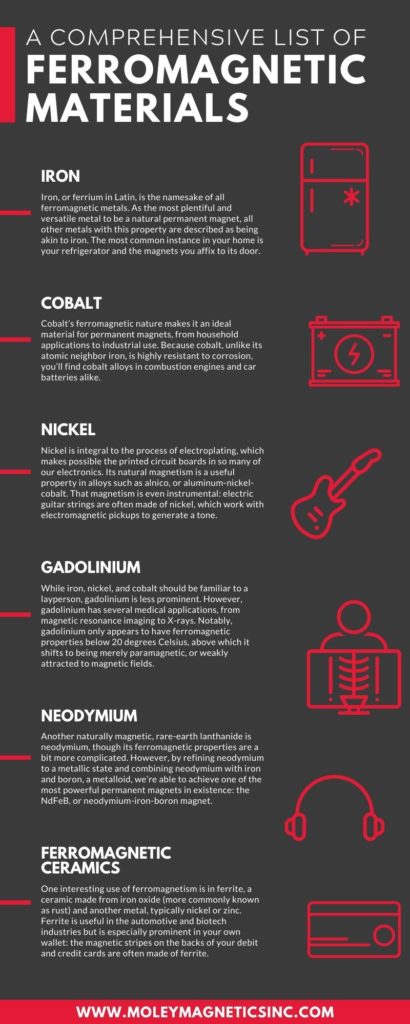
A Comprehensive List of Ferromagnetic Materials
Metals and magnetism go hand in hand. Magnetism, whether it’s strong or weak, is a characteristic of metal along with conductivity, malleability, and ductility. But just as metals can be ductile but not malleable, or malleable but not ductile, magnetism isn’t a condition to be taken for granted.
Metal infused with an electric current generates a magnetic field as long as the current flows through the metal. This is called a temporary magnet. But ferromagnetic metals, or “magnetic in the fashion of iron,” are permanent magnets generating their own magnetic fields without the aid of an electric current. Some of these metals should be readily familiar to you, while others have important uses in our lives yet aren’t metals we think much about by name. Learn more about all of them, familiar and unfamiliar, in this comprehensive list of ferromagnetic materials.
Iron
Iron, or ferrium in Latin, is the namesake of all ferromagnetic metals. As the most plentiful and versatile metal to be a natural permanent magnet, all other metals with this property are described as being akin to iron. From the Iron Age to the modern day, humanity has relied on ironworking to make significant progress. Of iron’s many uses, its most important is as a component of steel—an alloy of iron fortified with carbon at high temperatures. Without steel, we wouldn’t have the architecture, infrastructure, automobiles, and machinery that make modern living possible. Iron’s natural magnetism occurs in most steel alloys. The most common instance in your home is your refrigerator and the magnets you affix to its door. At the scrap yard, iron’s ferromagnetic properties reveal themselves under powerful electromagnets that separate ferrous and non-ferrous metals as recyclers search for metals with higher resale values than highly plentiful iron.
Cobalt
Cobalt, an element that often occurs alongside copper and nickel ore, is best known for pigments with a rich and radiant shade of blue—so much that “cobalt” is practically synonymous with deep blue. Elemental cobalt itself, however, is a lustrous grey, and has more uses than pigmentation. Cobalt alloys are a key component of the lithium-ion batteries that power our smartphones—perhaps even the very device you’re reading this on. Because cobalt, unlike its atomic neighbor iron, is highly resistant to corrosion, you’ll find cobalt alloys in combustion engines and car batteries alike. Cobalt’s ferromagnetic nature makes it an ideal material for permanent magnets, from household applications to industrial use.
Nickel
Nickel is the third of the “big three” ferromagnetic metals. If you have your Periodic Table at hand, you won’t be surprised to notice that iron, cobalt, and nickel have atomic numbers of 26, 27, and 28, respectively: they’re all what chemists refer to as transition metals. Though it’s best known as the metal in our five-cent coins, nickel has a number of applications beyond spare change. Nickel is integral to the process of electroplating, which makes possible the printed circuit boards in so many of our electronics. Nickel contributes to steel alloys, particularly stainless steel. Its natural magnetism is a useful property in alloys such as alnico, or aluminum-nickel-cobalt. That magnetism is even instrumental: electric guitar strings are often made of nickel, which work with electromagnetic pickups to generate a tone.
Gadolinium
The lanthanide and actinide series complicate the periodic table by extending Group III to the point that it must be set off in a separate inset on most tables. As such, they tend to be afterthoughts when studying chemistry, but the lanthanides and actinides loom large in modern technology. One of those lanthanides is gadolinium, a rare-earth metal with ferromagnetic properties much like the unrelated transition metals listed above. While iron, nickel, and cobalt should be familiar to a layperson, gadolinium is less prominent. However, gadolinium has several medical applications, from magnetic resonance imaging to X-rays. Notably, gadolinium only appears to have ferromagnetic properties below 20 degrees Celsius, above which it shifts to being merely paramagnetic, or weakly attracted to magnetic fields.
Neodymium
Another naturally magnetic, rare-earth lanthanide is neodymium, though its ferromagnetic properties are a bit more complicated. Elemental neodymium doesn’t occur naturally and must be refined. At this point, it’s only paramagnetic. However, by refining neodymium to a metallic state and combining neodymium with iron and boron, a metalloid, we’re able to achieve one of the most powerful permanent magnets in existence: the NdFeB, or neodymium-iron-boron magnet. Neodymium magnets are capable of lifting nearly a thousand times their own weight without an electric current. The music industry, from microphones to headphones, runs on neodymium magnets, which maintain strength and efficacy even at the tiny sizes of earbuds, pickups, and hard drives. Our continuing efforts to go green also rely heavily on neodymium magnets: electric automobile engines and electric turbines alike use NdFeB to power the world more cleanly.
Ferromagnetic Ceramics
Not all ferromagnetic materials are necessarily metals as we typically think of them. One interesting use of ferromagnetism is in ferrite, a ceramic made from iron oxide (more commonly known as rust) and another metal, typically nickel or zinc. Ferrite is useful in the automotive and biotech industries but is especially prominent in your own wallet: the magnetic stripes on the backs of your debit and credit cards are often made of ferrite. Though recording tape has fallen out of fashion, magnetic barium ferrite on plastic tape made it possible to record before the advent of hard drives. Recording tape is another item that relies on magnetism.
Ferromagnetism, while limited among elements, is certainly abundant in the world, and necessary to life as we know and enjoy it. The applications of ferromagnetic materials in everyday life, from the earbuds you use during your morning jog to the excavator magnets you use to tear down a structure and start anew, affect us all. Ferromagnetism is involved in things large and small, including the tool you’re using to read this blog. This comprehensive list of ferromagnetic materials should help you better understand the materials you encounter at job sites and scrap yards, and why they can be so valuable.


